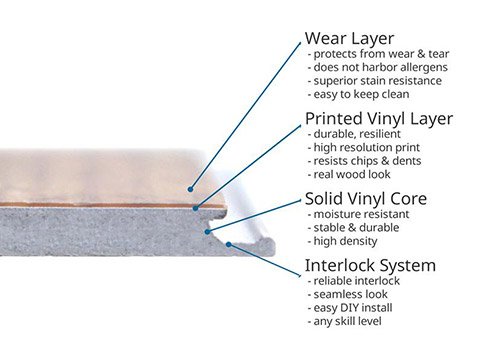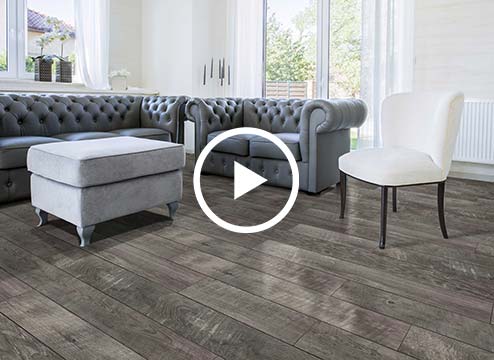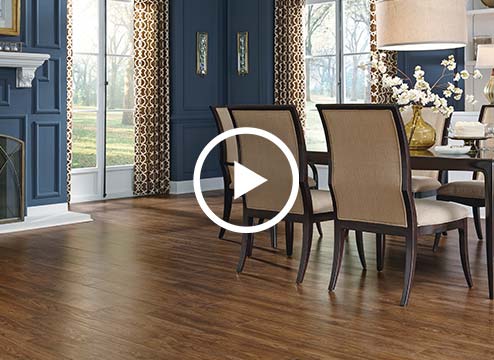Laminate vs Vinyl Flooring Buying Guide
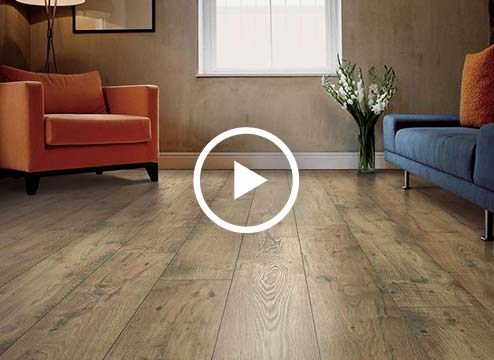
Learn the difference between vinyl and laminate flooring, the pros and cons of each and how to make the best decision for your home with our Laminate vs Vinyl Flooring showdown.
It’s true, if you’re not in the flooring industry or really up to date on house and home projects, you probably wouldn’t be able to pick out laminate or vinyl flooring out of a line-up. I mean tile, wood, even cork…is easy to pick out in a crowd, but these new wood-look next-gen flooring options are trickier and often misunderstood.
Laminate flooring has started to get a name for itself, but poor vinyl is the misunderstood red-headed stepchild that is secretly bright, brawny and beautiful. Okay, so if they both look like wood and aren’t wood, then what is the actual difference between vinyl and laminate flooring?
It’s true, if you’re not in the flooring industry or really up to date on house and home projects, you probably wouldn’t be able to pick out laminate or vinyl flooring out of a line-up. I mean tile, wood, even cork…is easy to pick out in a crowd, but these new wood-look next-gen flooring options are trickier and often misunderstood.
Laminate flooring has started to get a name for itself, but poor vinyl is the misunderstood red-headed stepchild that is secretly bright, brawny and beautiful. Okay, so if they both look like wood and aren’t wood, then what is the actual difference between vinyl and laminate flooring?
The video below covers laminate vs vinyl flooring in depth, but if you’re a reader, stick with me! I’ll explain how laminate and vinyl are constructed, go over their strengths and weaknesses and give you all the info you need to make your decision easier.
What is Laminate Flooring?
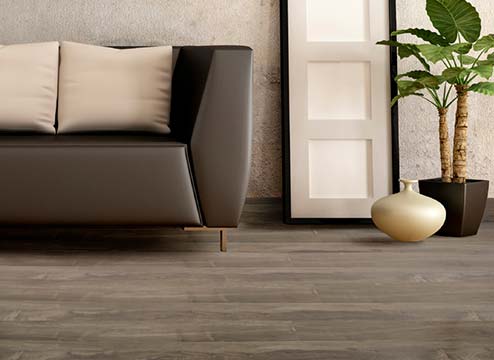
Let’s talk laminate.
Laminate flooring is a synthetic (man-made) floor that made a splash on the flooring market in the 1970’s. The first man-made alternative to natural wood, laminate quickly gained popularity as manufacturers created increasingly realistic looks that could easily pass for real hardwood.
Laminate was kind of the pioneer for realistic wood-look flooring, and other types of flooring have caught on and have begun releasing their own realistic wood looks, but more on that later. Laminate planks are solid without give and movement, similar to traditional hardwood.
Laminate flooring is a synthetic (man-made) floor that made a splash on the flooring market in the 1970’s. The first man-made alternative to natural wood, laminate quickly gained popularity as manufacturers created increasingly realistic looks that could easily pass for real hardwood.
Laminate was kind of the pioneer for realistic wood-look flooring, and other types of flooring have caught on and have begun releasing their own realistic wood looks, but more on that later. Laminate planks are solid without give and movement, similar to traditional hardwood.
Layers of Laminate Flooring
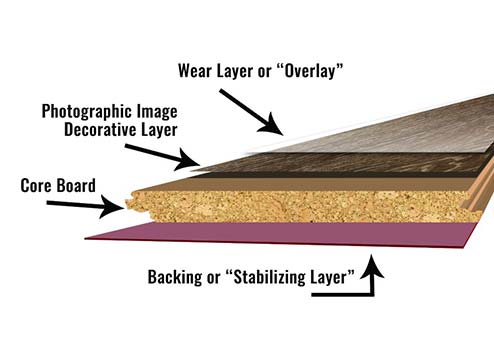
Laminate flooring is typically comprised of 4 layers.*
*Can vary between manufacturers.
*Can vary between manufacturers.
- Backing layer: This is the backbone of your laminate plank.
- Base layer: HDF or MDF core – HDF stands for high-density fiberboard and, unsurprisingly, MDF stands for medium density fiberboard. Higher quality products come with an HDF core, so if you’re getting a smokin’ deal, check out that layer – could be the reason why! The HDF core is moisture resistant, which gives you more options and less fuss than traditional hardwood. Fiberboards in water-resistant laminate floors may feature more resins, making it less susceptible to swelling in water.
- Print layer: The print layer is what most people will ooh and ahh over – it’s the design, the spectacle, the wow! Or, sometimes, it’s the deal breaker… ya know, if it’s ugly. Ain’t nobody got time for ugly. The print layer makes the laminate look like wood (or, now, stone, metal and more!) and can include rougher, more natural looking scrapes and knots just like the real deal. That’s right, it’s literally a photo (a really sweet, high-res photo) or the material being printed on your floor and, if you ask me, it is shockingly convincing.
- Wear layer: The wear layer is what protects your laminate floor. It’s the reason that 10 years from now, after the wear and tear of everyday life, your laminate will still look great.
Pros of Laminate Flooring
- Durable: Laminate flooring’s supreme durability makes it a good option for high-traffic areas or homes with kids and pets.
- Scratch resistance: Laminate has a strong wear layer that protects the floor from scratches, dents, wear and staining, all the things pets love to test our floors on.
- Realistic wood and stone looks: Laminate floor planks often have some surface detail to further mimic a natural hardwood look and can have the look and feel of a hand-scraped hardwood, embossed wood, distressed hardwood or come in textured or smooth. Unlike real hardwood, you’ll see consistent quality across all laminate flooring boards.
- Can resist some water: Advances in construction are improving laminate’s water-resistant capabilities. While it’s still not as waterproof as other wood-look options like vinyl flooring, most new laminate floors can withstand topical moisture. Proper installation helps keep water from seeping through the planks.
- Can be installed over radiant heating systems: You won’t find this feature with most hardwood flooring options.
- Easy to clean and maintain: Simply mop or sweep up messes as needed. No floor waxing is ever necessary.
- Easy to install: Laminate flooring is designed to be installed as a floating floor, meaning that it is not secured to the ground underneath, but rather “floats” by the means of an interlocking design.
- Easy to stand on for longer periods of time: Most laminate installations include underlayment, which can make the floor feel more comfortable underfoot.
- Cost effective: Laminate floors are an affordable alternative to hardwood floors. And when it comes to laminate vs vinyl flooring, laminate wins in the price category.
Cons of Laminate Flooring
- Not as water-resistant as vinyl flooring: While laminate flooring has come a long way in its water-resistant capabilities, it still cannot tolerate standing pools of water. Unlike vinyl, laminate’s water resistance works from top to bottom rather than bottom to top. If you have moisture issues with your subfloor, you’ll still need a vapor barrier.
- Not recommended for full bathrooms or basements: Since these areas are prone to leaks and flooding, you’ll want a more water-resistant floor. You can make your laminate floor more water resistant by installing an underlayment and vapor barrier as well as using the glue-down installation method.
- Sound: If installed poorly, laminate floors can create a hollow, empty sound. Every product comes with thorough installation instructions, and if you’re really worried, you can always hire an expert. Plus, a good underlayment can make for a quieter laminate floor.
What is Vinyl Flooring?
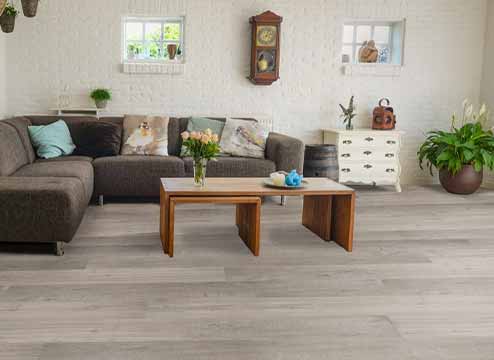
Now for the home team in this laminate vs vinyl flooring match.
Vinyl flooring is also man-made with looks resembling natural materials (wood, stone, etc.), but it’s a completely different animal with a whole lotta variety. For the sake of comparison, we’re going to stick to the
wood-look vinyl planks that people typically mistake for laminate.
Vinyl had a bad rap for a long time, but it is quickly taking over the market with luxury vinyl planks looking more realistic than ever. Vinyl is even less maintenance than laminate (as far as moisture and cleaning) and, if you ask me, it is that dark horse that is slowly, but surely, pulling ahead in the laminate vs vinyl flooring race.
Vinyl had a bad rap for a long time, but it is quickly taking over the market with luxury vinyl planks looking more realistic than ever. Vinyl is even less maintenance than laminate (as far as moisture and cleaning) and, if you ask me, it is that dark horse that is slowly, but surely, pulling ahead in the laminate vs vinyl flooring race.
Layers of Vinyl Flooring
The layers of vinyl are actually really similar to laminate, just using different materials. Vinyl is also typically comprised of 4 layers*
*Can vary between manufacturers.
*Can vary between manufacturers.
- Backing layer: Again, the backbone of your plank.
- Solid vinyl core: The solid vinyl core accounts for most of the flooring. This high-density core layer is moisture resistant, durable, and built to last.
- Print vinyl layer: Similar to laminate, this is where you get your gorgeous photo imagery that makes the vinyl look (nearly) identical to natural materials like stone and wood. As technology improves, you will see even more interesting vinyl looks, including leather, pebbles, chevron and more! For a long time, vinyl wasn’t able to produce anything that looked even remotely as realistic, beautiful or expensive as laminate, but times they are a-changin’!
- Wear layer: Just like with laminate, the wear layer is like your bodyguard; it helps protect your floor from dents, scratches, etc. The thicker the wear layer, the buffer your bodybuilder, you feel me? Thicker wear layers offer more protection, so make sure when you’re looking at vinyl flooring to look not just at plank thickness, but wear layer thickness as well.
Pros of Vinyl Flooring
- Realistic wood and stone looks: Seriously, vinyl is changing. Rapidly. The top-end vinyl floors are able to more realistically mimic natural materials better than ever before. WPC vinyl is the best of the best, which means the looks are usually incredibly convincing and beautiful.
- Easy, DIY installation: Most vinyl planks and tiles offer an easy interlocking or “floating” installation, perfect for most homeowners to do on their own without the help of an installation professional.
- Realistic wood and stone looks: Laminate floor planks often have some surface detail to further mimic a natural hardwood look and can have the look and feel of a hand-scraped hardwood, embossed wood, distressed hardwood or come in textured or smooth. Unlike real hardwood, you’ll see consistent quality across all laminate flooring boards.
- Easy to maintain: Vinyl flooring is super easy to take care of. Most options are water-resistant and many are fully waterproof. Just make sure you choose a thick wear layer to prevent scrapes and scratches.
- Zero maintenance: All you need is the occasional vacuum and damp mop to keep your WPC looking fabulous.
- Resilient: It’s true, you could just get a wood- or stone-look tile and it would also be waterproof. But tile is hard. Standing on a tile floor all day isn’t great for your joints or feet. Vinyl is more resilient and much more comfortable.
- Waterproof options: Yes, 100% waterproof. They are awesome!
Cons of Vinyl Flooring
- Doesn’t feel like real wood: To the touch, vinyl feels pretty different from solid hardwood. This feel is important to some homeowners.
- Price: As you move onto waterproof and luxury options, this can run you more than other wood-look options like laminate. But they come with a whole lot more bells and whistles!
- Low-quality planks scratch and dent easily: If you want a vinyl plank that can stand up to high traffic, family and pets, you’ve got to go with a high-quality plank with a thick wear layer. The cheaper options just won’t hold up.
Laminate vs Vinyl: Which One is Better?
Who’s the winner in our laminate vs vinyl flooring match? The real deal is this: There is no one-size-fits-all answer. The “better” option is mostly a matter of opinion. However, we can totally break things down on a point-by-point basis, so you can decide what is best for you.
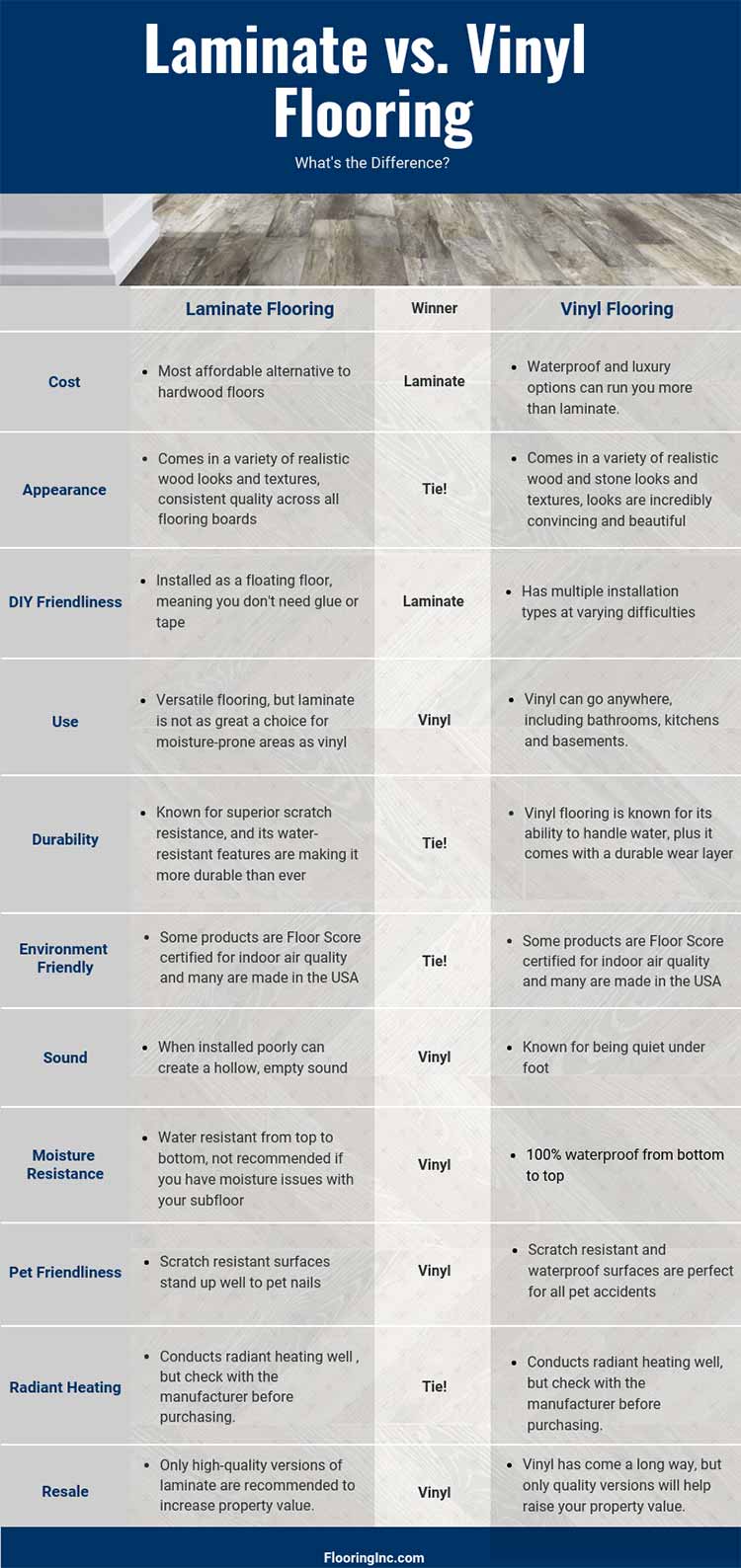
Cost
Honestly, for vinyl flooring vs laminate…it depends. I know…rude, right?
Well, there is a wide range for both laminate and vinyl flooring products. However, I will say that for the top end luxury vinyl, you may pay a little more than for the top end of laminate. That is because the highest quality luxury vinyl often includes a waterproof core** and ultra thick wear layer.
For the middle of the road, beautiful and good quality options, they are honestly pretty comparable, and I would say that vinyl has a wider range on both ends of the spectrum. It is also important to discuss installation costs with your installer. One may cost more for the install and that could alter which flooring is less expensive in the long run.
**Fun fact: There was a little experiment conducted with our luxury COREtec vinyl planks. They were submerged in water for six months and the flooring did not swell at all!
Well, there is a wide range for both laminate and vinyl flooring products. However, I will say that for the top end luxury vinyl, you may pay a little more than for the top end of laminate. That is because the highest quality luxury vinyl often includes a waterproof core** and ultra thick wear layer.
For the middle of the road, beautiful and good quality options, they are honestly pretty comparable, and I would say that vinyl has a wider range on both ends of the spectrum. It is also important to discuss installation costs with your installer. One may cost more for the install and that could alter which flooring is less expensive in the long run.
**Fun fact: There was a little experiment conducted with our luxury COREtec vinyl planks. They were submerged in water for six months and the flooring did not swell at all!
Look/Feel
As far as looks go in laminate vs vinyl flooring, you can find ultra-realistic wood looks in both types. The feel? That is a different story. Laminate, when installed poorly, can also create a hollow, empty sound which can be a deal breaker for many homeowners.
Installation
Use
Laminate is great for places that won’t see a lot of moisture. Full bathrooms and basements prone to leaks and flooding are not recommended for traditional laminate flooring. Kitchens are okay, but the floor will need to be treated more carefully when it comes to spills. Water-resistant laminate floors are better for these areas, but even those are still not as resistant to moisture as vinyl.
You can install vinyl literally anywhere! Bathrooms, kitchens, basements, you name it! For vinyl flooring vs laminate, vinyl definitely wins points in the versatility department, particularly where moisture is concerned.
You can install vinyl literally anywhere! Bathrooms, kitchens, basements, you name it! For vinyl flooring vs laminate, vinyl definitely wins points in the versatility department, particularly where moisture is concerned.
Durability
Like all things, not all laminates and not all vinyl floors are created equal. However, high end for high end, laminate and vinyl are both very durable floors with long shelf lives.
For a long time, laminate flooring was thought to be much more durable but, if you ask me, vinyl can now do everything laminate can do and handle water better!
For a long time, laminate flooring was thought to be much more durable but, if you ask me, vinyl can now do everything laminate can do and handle water better!
Effect on Environment
Okay, okay, so I know vinyl got a bad rap for a long time, but nowadays, vinyl and laminate are actually equally eco-friendly, so you don’t need to feel guilty about choosing one over the other! Some products are even Floor Score certified for indoor air quality, and some are made in the USA!! You’re welcome.
Laminate vs Vinyl Flooring: Which Floor is Best for You?
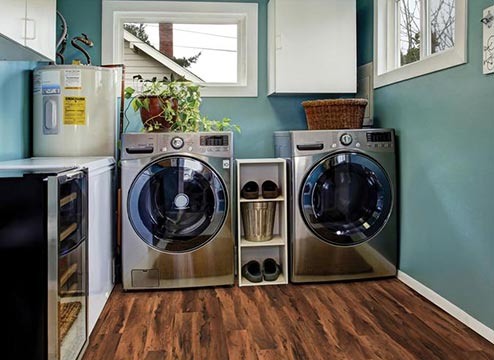
The winner of laminate vs vinyl flooring is really up to you. Both are strong, beautiful floors that are less expensive than natural wood, but if easy installation is your most important factor, laminate flooring is the more DIY friendly option (though we have plenty of instructions on installing vinyl as well!). If moisture resistance is your biggest concern, waterproof vinyl flooring will give you the most confidence.
Give each of these pros and cons some thought, and determine what’s most important to you in laminate vs vinyl flooring. The best part is, you can order free samples of both laminate and vinyl and compare and contrast for yourself.
Give each of these pros and cons some thought, and determine what’s most important to you in laminate vs vinyl flooring. The best part is, you can order free samples of both laminate and vinyl and compare and contrast for yourself.


